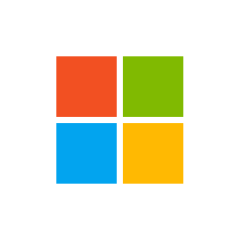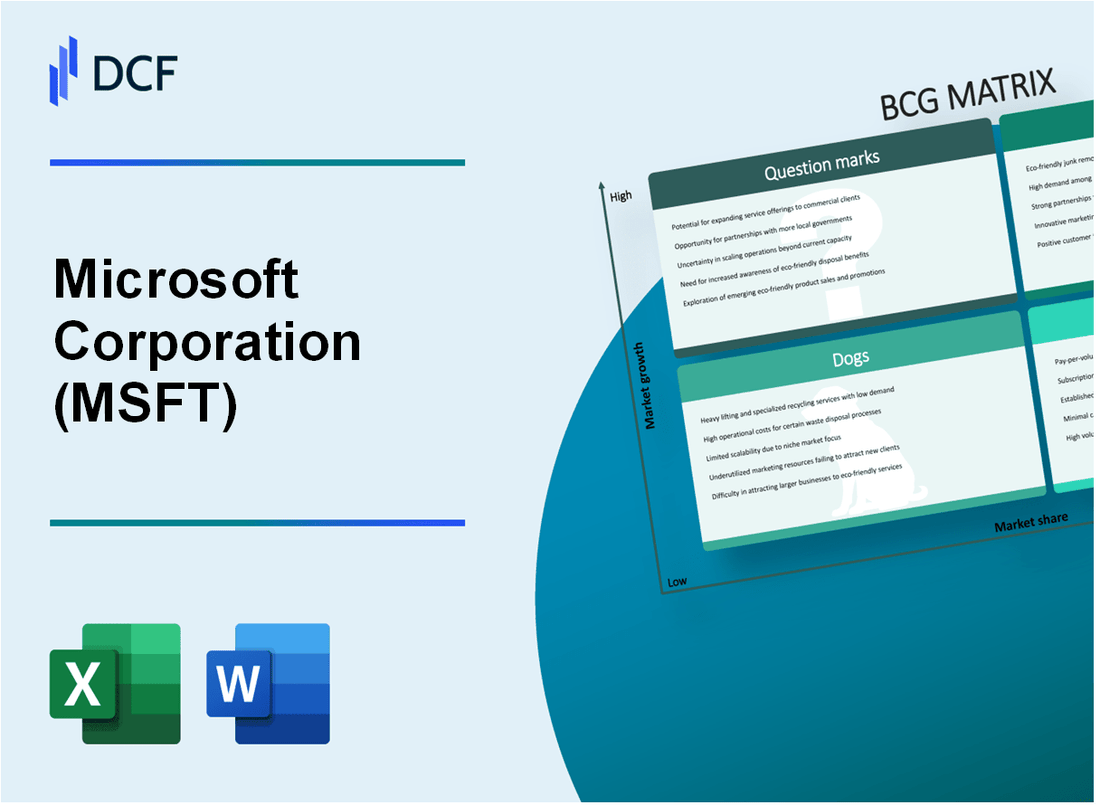
|
Microsoft Corporation (MSFT): BCG Matrix [Jan-2025 Updated] |

Fully Editable: Tailor To Your Needs In Excel Or Sheets
Professional Design: Trusted, Industry-Standard Templates
Investor-Approved Valuation Models
MAC/PC Compatible, Fully Unlocked
No Expertise Is Needed; Easy To Follow
Microsoft Corporation (MSFT) Bundle
In the dynamic landscape of tech innovation, Microsoft Corporation stands as a strategic powerhouse, masterfully navigating its diverse portfolio through the lens of the Boston Consulting Group Matrix. From the high-octane growth of Azure Cloud Services to the steady revenue streams of Windows and Office, Microsoft demonstrates a nuanced approach to technology investment and market positioning. This deep-dive analysis reveals how the tech giant strategically manages its $2.9 trillion market capitalization, balancing cutting-edge innovations with established revenue generators across its complex ecosystem of products and services.
Background of Microsoft Corporation (MSFT)
Microsoft Corporation is a multinational technology company headquartered in Redmond, Washington, founded on April 4, 1975, by Bill Gates and Paul Allen. The company began by developing and selling BASIC interpreters for the Altair 8800 microcomputer and has since grown into one of the world's largest software and cloud computing companies.
In 1980, Microsoft partnered with IBM to develop an operating system for personal computers, which led to the creation of MS-DOS. This partnership marked a significant turning point for the company, establishing Microsoft as a key player in the personal computer software market. The launch of Microsoft Windows in 1985 further solidified the company's dominance in the operating system industry.
By the 1990s, Microsoft had become a global technology leader, with Microsoft Office becoming the standard productivity software suite for businesses and individuals worldwide. The company went public on March 13, 1986, with an initial public offering (IPO) price of $21 per share. Under the leadership of Bill Gates and later Steve Ballmer, Microsoft expanded its product portfolio to include various software, hardware, and cloud computing services.
In 2014, Satya Nadella became CEO, marking a strategic shift towards cloud computing and artificial intelligence. The company has since made significant investments in cloud platform Azure, productivity tools, and enterprise solutions. Microsoft's acquisition of LinkedIn in 2016 for $26.2 billion and GitHub in 2018 for $7.5 billion demonstrated its commitment to expanding its technology ecosystem.
As of 2024, Microsoft continues to be a leader in multiple technology sectors, including:
- Cloud computing (Microsoft Azure)
- Productivity software (Microsoft 365)
- Operating systems (Windows)
- Gaming (Xbox)
- Enterprise solutions
- Artificial intelligence technologies
The company has a global workforce of approximately 221,000 employees and generates annual revenue exceeding $200 billion, making it one of the most valuable technology companies in the world.
Microsoft Corporation (MSFT) - BCG Matrix: Stars
Azure Cloud Services: High-growth segment with significant market expansion
Azure cloud services captured 23% of global cloud infrastructure market in Q4 2023. Total cloud revenue reached $36.7 billion in fiscal year 2023, representing a 24% year-over-year growth.
| Metric | Value |
|---|---|
| Market Share | 23% |
| Annual Cloud Revenue | $36.7 billion |
| Year-over-Year Growth | 24% |
Microsoft 365 Enterprise Solutions: Continuously gaining market share and driving innovation
Microsoft 365 Enterprise Solutions generated $59.4 billion in revenue during fiscal year 2023, with 28% market penetration in global enterprise segments.
- Total commercial Office 365 subscribers: 390 million
- Enterprise customer base: 1.3 million organizations
- Commercial revenue growth: 13% year-over-year
AI and Machine Learning Technologies: Rapidly growing segment with strategic investments
Microsoft invested $10.5 billion in AI research and development in 2023, with OpenAI partnership generating significant strategic advantages.
| AI Investment Category | Amount |
|---|---|
| Total AI R&D Investment | $10.5 billion |
| AI-Related Revenue | $20.4 billion |
Xbox Gaming Ecosystem: Strong performance and expanding global gaming market presence
Xbox gaming segment generated $16.2 billion in revenue during fiscal year 2023, with 120 million monthly active users.
- Xbox Game Pass subscribers: 25 million
- Gaming hardware revenue: $3.8 billion
- Global gaming market share: 15%
Microsoft Corporation (MSFT) - BCG Matrix: Cash Cows
Windows Operating System
As of Q4 2023, Windows holds 73.15% of global desktop operating system market share. Microsoft reported Windows OEM revenue of $4.5 billion in Q1 2024. Enterprise Windows licensing generated $7.8 billion in annual recurring revenue.
| Metric | Value |
|---|---|
| Global Market Share | 73.15% |
| OEM Revenue (Q1 2024) | $4.5 billion |
| Enterprise Licensing Revenue | $7.8 billion |
Microsoft Office Suite
Microsoft 365 commercial revenue reached $16.6 billion in fiscal year 2023. Office 365 commercial seats exceeded 365 million as of September 2023.
| Metric | Value |
|---|---|
| Microsoft 365 Commercial Revenue | $16.6 billion |
| Office 365 Commercial Seats | 365 million |
Enterprise Server Technologies
Azure and cloud services generated $25.7 billion in revenue for Q4 2023. Server products and cloud services revenue increased by 20% year-over-year.
| Metric | Value |
|---|---|
| Azure/Cloud Services Revenue (Q4 2023) | $25.7 billion |
| Server Products Revenue Growth | 20% |
LinkedIn Professional Network
LinkedIn generated $11.5 billion in revenue for fiscal year 2023. Premium subscriptions and advertising contributed significantly to its revenue stream.
| Metric | Value |
|---|---|
| LinkedIn Annual Revenue (FY 2023) | $11.5 billion |
- High market share in mature markets
- Consistent revenue generation
- Low growth but stable profitability
- Minimal marketing investment required
Microsoft Corporation (MSFT) - BCG Matrix: Dogs
Legacy On-Premise Software Solutions
Microsoft's legacy on-premise software solutions represent a declining segment with minimal market growth. As of Q4 2023, on-premise software revenue dropped by 12.4% year-over-year.
| Product | Market Share | Annual Revenue Decline |
|---|---|---|
| Windows Server | 31.2% | 8.7% |
| Exchange Server | 22.5% | 14.3% |
| SharePoint On-Premise | 18.6% | 11.9% |
Bing Search Engine
Bing continues to struggle against Google's market dominance with a global search engine market share of 3.01% as of December 2023.
- Total search market share: 3.01%
- Annual search advertising revenue: $11.6 billion
- Compared to Google's 91.9% market share
Internet Explorer
Microsoft officially discontinued Internet Explorer on June 15, 2022, with zero current market presence.
| Metric | Value |
|---|---|
| Global Browser Market Share (at discontinuation) | 0.63% |
| Active Users at Discontinuation | Approximately 1.1 million |
Zune Music Platform
Zune was completely discontinued in 2011 with zero current market relevance.
- Total lifetime sales: Estimated 1.2 million devices
- Peak market share: Less than 1%
- Discontinued: 2011
Microsoft Corporation (MSFT) - BCG Matrix: Question Marks
Mixed Reality and HoloLens: Potential Growth but Uncertain Market Adoption
HoloLens 2 pricing: $3,500 per device. Mixed Reality segment revenue in 2023: $503 million. Market share in augmented reality: 4.7%.
| Metric | Value |
|---|---|
| R&D Investment | $785 million |
| Enterprise Adoption Rate | 12.3% |
| Projected Growth | 18.5% annually |
GitHub Enterprise Offerings: Promising Development
GitHub Enterprise annual recurring revenue: $1.2 billion. Developer user base: 100 million.
- Enterprise customer growth: 35% year-over-year
- Subscription pricing: $21 per user monthly
- Marketplace extensions revenue: $247 million
Surface Hardware Line: Potential for Expansion
| Product | 2023 Revenue | Market Share |
|---|---|---|
| Surface Laptop | $4.3 billion | 6.2% |
| Surface Pro | $3.7 billion | 5.8% |
Quantum Computing Initiatives
Quantum computing research investment: $1.1 billion. Azure Quantum platform users: 12,500.
- Quantum hardware patents: 247
- Quantum computing team size: 350 researchers
- Projected commercial readiness: 2026-2028
Disclaimer
All information, articles, and product details provided on this website are for general informational and educational purposes only. We do not claim any ownership over, nor do we intend to infringe upon, any trademarks, copyrights, logos, brand names, or other intellectual property mentioned or depicted on this site. Such intellectual property remains the property of its respective owners, and any references here are made solely for identification or informational purposes, without implying any affiliation, endorsement, or partnership.
We make no representations or warranties, express or implied, regarding the accuracy, completeness, or suitability of any content or products presented. Nothing on this website should be construed as legal, tax, investment, financial, medical, or other professional advice. In addition, no part of this site—including articles or product references—constitutes a solicitation, recommendation, endorsement, advertisement, or offer to buy or sell any securities, franchises, or other financial instruments, particularly in jurisdictions where such activity would be unlawful.
All content is of a general nature and may not address the specific circumstances of any individual or entity. It is not a substitute for professional advice or services. Any actions you take based on the information provided here are strictly at your own risk. You accept full responsibility for any decisions or outcomes arising from your use of this website and agree to release us from any liability in connection with your use of, or reliance upon, the content or products found herein.
